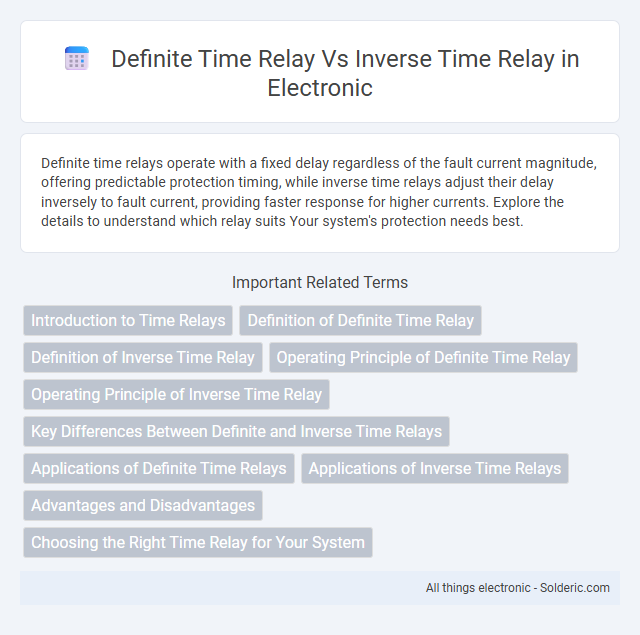Definite time relays operate with a fixed delay regardless of the fault current magnitude, offering predictable protection timing, while inverse time relays adjust their delay inversely to fault current, providing faster response for higher currents. Explore the details to understand which relay suits Your system's protection needs best.
Comparison Table
| Feature | Definite Time Relay | Inverse Time Relay |
|---|---|---|
| Operating Principle | Fixed time delay after fault detection | Time delay inversely proportional to fault current magnitude |
| Time Delay | Constant, preset time | Variable, decreases with increasing current |
| Application | Simple protection scenarios, backup protection | Overcurrent protection with coordination |
| Coordination | Limited, fixed-time can cause coordination issues | Better coordination with other relays |
| Sensitivity to Fault Current | Insensitive; operates after set time regardless | Sensitive; faster trip for higher fault currents |
| Complexity | Simple design and setting | More complex time-current characteristic settings |
| Typical Use Case | Motor starting, simple time delay needs | Feeder protection, selective tripping |
Introduction to Time Relays
Definite time relays operate with a fixed time delay before tripping, enabling precise control over the timing of electrical circuits. In contrast, inverse time relays adjust their trip delay based on the magnitude of the current, providing faster response during higher fault currents for effective protection. Your choice between these time relays impacts the coordination and selectivity of protection in electrical systems.
Definition of Definite Time Relay
Definite time relays operate with a fixed time delay, activating or deactivating a circuit after a preset interval regardless of load conditions. This type of relay is commonly used in protection systems where a constant delay is crucial for coordination and selectivity. Definite time relays differ fundamentally from inverse time relays, which adjust their response time based on the magnitude of the current or other input variables.
Definition of Inverse Time Relay
Inverse time relay is a protective device whose operation time decreases as the magnitude of the fault current increases, providing variable delay proportional to the current level. It contrasts with definite time relay that operates after a preset fixed time regardless of current magnitude. Inverse time relays offer improved coordination and selectivity in power system protection by adapting response time to fault severity.
Operating Principle of Definite Time Relay
The operating principle of a definite time relay involves a fixed time delay after a fault current reaches a preset level, activating the relay to isolate the circuit promptly. This type of relay operates regardless of the magnitude of the fault current beyond the set threshold, ensuring predictable and consistent response times for protection. Your electrical system benefits from the precise and reliable operation of definite time relays, especially in applications requiring strict time coordination.
Operating Principle of Inverse Time Relay
Inverse time relays operate based on the principle that the trip time decreases as the magnitude of the fault current increases, providing faster protection during more severe faults. This characteristic allows the relay to mimic the time-current behavior of circuit breakers, ensuring selective coordination and minimizing equipment damage. Your electrical system benefits from improved reliability and precise fault detection with the inverse time relay's adaptable response.
Key Differences Between Definite and Inverse Time Relays
Definite time relays operate with a fixed time delay regardless of the magnitude of the current, providing precise and predictable trip timing ideal for coordination in protection systems. Inverse time relays adjust the trip time based on the magnitude of the current, with higher currents causing shorter delays, enhancing sensitivity to fault severity. The key difference lies in their time-current characteristics: definite time relays offer constant delay, while inverse time relays provide variable delay inversely proportional to current magnitude.
Applications of Definite Time Relays
Definite time relays are primarily used in applications where a fixed delay is required regardless of the current magnitude, such as backup protection in distribution circuits and motor starting sequences. These relays provide precise timing for controlling operations like load shedding, switching, and coordination with other protective devices. Their consistent response time makes them ideal for scenarios demanding predictable and repeatable timing actions.
Applications of Inverse Time Relays
Inverse time relays are commonly used in power systems for overcurrent protection, where the trip time decreases as the current increases, providing faster response to severe faults. These relays are ideal for coordinating with other protective devices, ensuring selective isolation of faulty sections and minimizing system downtime. Your electrical network benefits from enhanced reliability and safety by using inverse time relays to effectively manage fault conditions.
Advantages and Disadvantages
Definite time relays provide a fixed delay before tripping, ensuring predictable and simple coordination, but may lack sensitivity to varying fault conditions. Inverse time relays adjust trip timing based on current magnitude, offering better protection against overloads and faults by responding faster to severe faults, though their complexity can complicate settings and coordination. Your choice depends on the required balance between simplicity and adaptive protection for your electrical system.
Choosing the Right Time Relay for Your System
Selecting the right time relay depends on the specific protection requirements and operational characteristics of your electrical system. Definite time relays provide a fixed time delay beneficial for applications demanding consistent response times, while inverse time relays offer variable delays that decrease with increasing fault current, ideal for coordinating with upstream devices. Understanding load profiles and fault current levels ensures optimal relay coordination, minimizing equipment damage and enhancing system reliability.
Definite time relay vs inverse time relay Infographic

 solderic.com
solderic.com